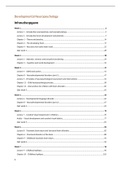Developmental Neuropsychology
Inhoudsopgave
Week 1.......................................................................................................................................................... 2
Lecture 1 – Introduction neuroanatomy and neurophysiology............................................................................2
Lecture 2 – Introduction brain development and plasticity.................................................................................7
Chapter 1 – Theory and practice........................................................................................................................14
Chapter 2 – The developing brain......................................................................................................................17
Chapter 4 – Recovery from early brain insult.....................................................................................................22
Quiz week 1........................................................................................................................................................28
Week 2........................................................................................................................................................ 28
Lecture 3 – Attention, memory and executive functioning................................................................................29
Chapter 3 – Cognitive and social development..................................................................................................35
Week 3........................................................................................................................................................ 41
Lecture 4 – ADHD and autism............................................................................................................................41
Chapter 8 – Neurodevelopmental disorders (part 1).........................................................................................47
Lecture 5 – Principles of neuropsychological assessment and interventions.....................................................52
Chapter 11 – Child neuropsychology practice....................................................................................................58
Chapter 12 – Interventions for children with brain disorders............................................................................60
Quiz week 3........................................................................................................................................................62
Week 4........................................................................................................................................................ 64
Lecture 6 – Developmental language disorder..................................................................................................64
Chapter 8 – Neurodevelopmental disorders (part 2).........................................................................................67
Quiz week 4........................................................................................................................................................69
Week 5........................................................................................................................................................ 70
Lecture 7 – Cerebral Visual Impairment in Children...........................................................................................70
Article – Visual development and cerebral visual deficits..................................................................................77
Quiz week 5........................................................................................................................................................81
Week 6........................................................................................................................................................ 82
Lecture 8 – Traumatic brain injury and structural brain disorders....................................................................82
Chapter 6 – Structural disorders of the brain.....................................................................................................88
Chapter 9 – Childhood traumatic brain injury....................................................................................................92
Quiz week 6........................................................................................................................................................96
Week 7........................................................................................................................................................ 96
Lecture 9 – Childhood epilepsy...........................................................................................................................96
Chapter 10 – Childhood epilepsy......................................................................................................................102
1
,Week 1
Lecture 1 – Introduction neuroanatomy and neurophysiology
2
,Brain structure (connectoom) refers to the separate brain areas, the connection between
these areas (white nerve tracts) and their cell structure.
Brain function refers to the role of the separate brain areas and to the communication
between and within these areas, a global level (organization of brain networks), local level
(function of brain area) and the micro level (neurophysiology).
Terminology:
Cerebral cortex: higher cognitive functions which
consists of gyri and sulci, and has a layered cell
structure (6 cell layers).
Gray matter contains cell bodies and dendrites.
White matter are myelinated axons.
Central nervous system (CNS): brain and spinal cord
Peripheral nervous system (PNS): Somatic nervous system and autonomic nervous system:
Contains all neural structures outside the brain:
– The ability to sense what is going on outside and inside the body: afferent (rising)
nerve tracts
– The ability to respond with our muscles and glands: efferent (descending) nerve
tracts
The somatic (voluntary) nervous system is composed of:
– the sensory (afferent) neurons: that carry messages from outside the body to the
central nervous system; specialized in transmitting messages from the eyes, ears, and
other sensory receptor
– the motor (efferent) neurons: that carry messages from the central nervous system
to the skeletal muscles of the body; send messages from the brain and spinal cord to
the muscles that control voluntary movements.
3
, Every deliberate action a person makes involves neurons in the somatic nervous system.
Autonomic nervous system:
– Regulates the internal environment of the body, such as respiration, circulation, and
digestion
– Senses the body’s internal functions, control the glands and the smooth (involuntary)
muscles of the heart, blood vessels, stomach etc.
– Also involved in aspects of motivation, emotional behaviour, and stress responses.
Autonomic nervous system can be further divided into
– Sympathetic nervous system: activation or arousal, flight-or-flight response
– Parasympathetic nervous system: slows down body processes and maintains a state
of tranquility
Functions of the spinal cord:
– Contains motor and sensory nerves
– Organization of reflexes
– Central pattern generators (rhythmic movements, such as walking and swimming)
Hindbrain:
• Brain stem supports vital life functions
– Medulla: heart rate and respiration
– Pons: sleep and arousal
• Cerebellum involved in complex rapidly changing movements that require precise
timing, memory, and learning
Midbrain:
The midbrain or mesencephalon (associated with vision, hearing, motor control, sleep and
wakefulness, arousal (alertness), and temperature regulation)
– Tectum and tegmentum
Tectum receives input from eyes and ears
– Superior colliculus (input from optic nerve)
– Inferior colliculus (input auditory nerve)
– Both integrate information and give direct commands to the muscles
Tegmentum
– red nucleus (a role in motor co-ordination)
– Substantia nigra (produces dopamine, involved in motor-planning, learning,
addiction, and other functions)
– Ventral tegmental area contains a complex synaptic network of neurons,
primarily involved in homeostasis and reflex actions and is the largest
dopamine-producing area in the brain, and is heavily involved in the neural
reward system
Forebrain:
Hypothalamus
– Motivation and emotion: sexual behaviour, temperature regulation, sleeping,
eating, drinking, pleasure-displeasure, aggression, and hormone regulation
(direct contact with the pituitary gland)
Thalamus
4






